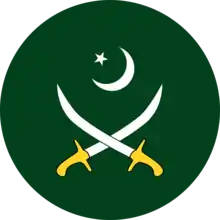Pakistan Military Academy
Pakistan Military Academy (PMA or PMA Kakul; Urdu: پاکستان عسکری اکادمی) is a Pakistan Army officers training academy located near Kakul village in the city and district of Abbottabad, Khyber Pakhtunkhwa[1] established in 1947.[2] It is the sole academy in Pakistan worked with transforming cadets into Army Officers. For educational training the institution is accredited with NUST University.[3][4][5] Cadets have to go through 2 years of vigorous military training until they can finally be termed an Officer. Pakistan Military Academy provides training to Gentlemen Cadets (Officer Cadets) of Pakistan Army and Allied countries. The academy has four training battalions, and 16 companies. Approximately 2,000 invited guests from over 34 countries visit this institution each year. Many close allies of Pakistan send their own cadets and officers to receive premier training in modern military doctrine at PMA.
پاکستان عسکری اکادمی | |
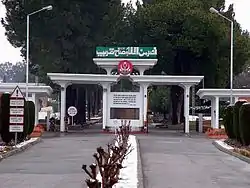 Pakistan Military Academy Entrance | |
Motto in English | Men at their Best |
|---|---|
| Type | military service academy |
| Established | August 14, 1947 |
| Commandant | Major-General Omer Ahmed Bokhari |
Academic staff | 3,000–4,000 (both civilian and military) |
| Location | , , |
| Colours | Green and Red |
| Website | www.pma.edu.pk |

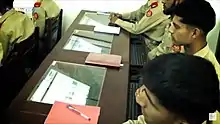
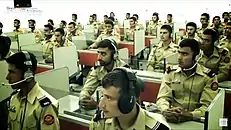
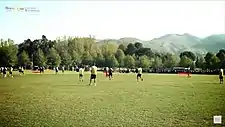
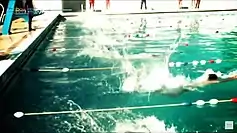
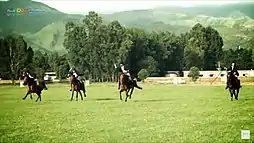
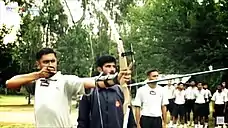
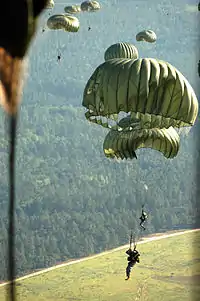
Former COAS Gen Raheel Shareef, inaugurated 4th Pakistan Battalion in PMA on October 10, 2016.[6][7]
History
Before the dissolution of British India in 1947, the location had initially been used as the premises of a PT and Mountaineering School of the British Indian Army, on the site of an old POW Camp for prisoners from the Boer War,[8] and later it became the premises of the Royal Indian Army Service Corps. After the division of the old Indian Army between India and Pakistan in 1947, Brigadier Francis Ingall, an officer of the British Indian Army, was selected by the C-in-C India, Field Marshal Sir Claude Auchinleck, as first commandant of the Pakistan Military Academy, established at Kakul. He determined that the PMA would be organized based upon the model established by Sandhurst and requested a regimental sergeant major from the Brigade of Guards to help with training. He was fortunate to have the support of a number of old Indian Army officers who were transferred to the Pakistan Army, among them Lieutenant-Colonel Attiqur Rahman, Major S.G.Mehdi M.C., the first PMA adjutant and founder of Qasim company, fondly known as "Killer" Mehdi, who later went on to command the SSG ( Special Service Group) of the Pakistan Army. In spite of facilities which were nowhere near the level of those enjoyed by the Indian Military Academy at Dehra Dun, Ingall won the confidence of his cadets and instructors. When, late in 1947, the dispute over the accession of Jammu and Kashmir led to armed conflict between India and Pakistan, Ingall was able to structure the Academy’s training to enable newly commissioned officers to be immediately effective when they joined units on active service. Ingall was appointed OBE after completing his term as commandant in 1950. What probably gave him more satisfaction was the decision to name Kakul’s central lecture theatre Ingall Hall - though this was not built until many years after he had left.[9] He kept in touch with the academy for the rest of his life, making his last visit in November, 1997 where he said:
I have given many addresses from this position here and from 1948 to 1951 I was very keen on the question of Pakistan and believed in it. I believed what the Quaid-e-Azam preached. I believe in Islam.[10]
Cadets from IMA (66) arrived in October 1947 and new cadets for Ist PMA Long Course (78) and Ist Graduates Course (63) were selected in Pakistan and training started officially in January 1948. Two hundred and seven cadets started their training in January 1948. On January 25, 1948, "The First Pakistan Battalion" was instituted. This battalion has four companies which were "named after the luminaries of Muslim military history" (e.g., Khalid, Tariq, Qasim, and Salahuddin). In March 1948, the First Battalion "was bestowed with Quaid-e-Azam’s patronage as Colonel-in-Chief, and the most coveted claim “The Quaid-e-Azam’s Own".
Khawaja Nazimuddin gave the Quaid-e-Azam banner to the Pakistan Military Academy on behalf of Quaid-e-Azam Mohammed Ali Jinnah. The Quaid-e-Azam banner is held aloft by the champion company at every passing out parade. "Regimental colours presented in 1950 by Liaquat Ali Khan, the first Prime Minister of Pakistan and the National Standard in 1961 by General Muhammad Musa, the then-Commander-in-Chief of the Pakistan Army, have been some of the honours showered on the Academy, which it has always zealously guarded and kept high in letter and spirit."[5]
The 1965 war led to expansion of the academy, and the second battalion of the academy was created in December 1965. This battalion consisted of four companies, called Ghaznavi, Babur, Aurangzeb, and Tipu. In early 1989, the third battalion of the academy was founded. The third battalion's four companies are Haider, Ubaida, Saad, and Hamza.
Educational philosophy
The academy offers a two-year undergraduate program leading to the Bachelors in Military Art and Science (BMAS) including some common subjects as English, Military Geography, National and International Affairs, Islamic Studies, Military and General Science or Social Science. The long course cadets study two years for the degree before commissioning and complete their degree in their units. Every Gentleman Cadet passing out of the academy has a minimum graduation (from MCE, CEME, MCS, AM College or civil institutes) except for Long Course cadets who complete their degree after their passing out.
The academy believes in proper grooming of a cadet and proper induced discipline. It is based on the principles of Discipline, Honor, Patriotism and the qualities are strictly monitored. Cadets are made to go through current world affairs and ammunition with everything taught being in relation to military. Cadets are also made to adore officer traditional code of conduct and are perfectly sculptured into an Army Officer by the end of their term. Communication skills are given great importance and courteousness and consistency are kept a record of and stressed upon. Cadets are provided with modern educational facilities and are equipped with modern labs to boaster learning. A cadet is also made to react during stress situations and his overall mental capability is worked on.
War tactics are presented to cadets and are part of the curriculum. These include discussion of previous war models and the ones to be used in future. Cadets are also given navigation training in equipped map rooms and then overall judged in the tactical exercises without troops and professionalism are judged in weapon training areas.[11]
Physical requirements
GCs (Gentlemen Cadets) are required to pass various physical tests. The academy has very high physical standards, which all cadets have to achieve in order to pass. The physical requirements increase with promotion to the next term. The basic requirement for cadets of first term is to be able to complete one mile run (1.6 kilometers) in six minutes and thirty seconds. In second term, cadets are required to complete one mile run in six minutes and fifteen seconds. For third term cadets one mile time is six minutes and for fourth term cadets i.e. the senior most cadets are required to run one mile within six minutes. Other tests includes push ups, sit ups, chin up, rope test, five mile running, assault course, and the acid test. These tests generally test the stamina and strength of a cadet.
In the acid test, cadets begin by traversing a mountain while carrying logs on their shoulders. This is followed by a 14.5 km run in full gear to an obstacle course. Those completing the course are given five rounds with which to hit a target at a distance of 22m.[12]
Lady Cadets are also required to pass physical efficiency tests like GCs, but the standards are bit less keeping in view to their physique. The basic requirement for all lady cadets is to run one mile (1.6 km) within ten minutes. Other tests includes push ups, sit ups, bar hanging, assault course and also undergoes an exercise Qiyadat with GCs.
There are a number of training exercises for cadets, which include:
- First term: Kick Off, Saluting Tests, Cross Country, Sang e Bunyad, Yarmuk, Path Finder and the GCs are required to spend three minutes in the Boxing Ring with another opponent following a lengthy training period.
- Second term: T.M Raiders, Panipat and Assault Course is also added as a part of PT Tests. Qiyadat and the Acid Test.
Battalions
For the sake of training the Gentlemen Cadets are organized in battalions and then further into companies. There are 16 companies in Pakistan Military Academy, all of them are named after famous Muslim warriors and commanders.
1st Pakistan Battalion (Quaid-I-Azam's own)
1st Pakistan Battalion consists of four companies:
2nd Pakistan Battalion (Quaid-i-Azam's own)
2nd Pakistan Battalion consists of four companies:
3rd Pakistan Battalion (Quaid-i-Azam's own)
3rd Pakistan Battalion consists of four companies:
4th Pakistan Battalion (Quaid-i-Azam's own)
4th Pakistan Battalion consists of four companies:
- Akram
- Karnal Sher Khan
- Aziz Bhatti
- Shabbir Sharif
Courses
There are five courses running parallel to each other. The courses are:
- PMA Long Course
The PMA Long Course is for regular commission officers of combat and combat support arms & services. The Long Course has a duration of two years, which is further divided into four terms of six months each. After the 2-year training period Cadets pass out as 2nd Lieutenants.
- Technical Cadet Course (TCC)
Candidates who wish to join the army as an engineer apply for this course. It is necessary that the candidate has attained 12 years of academic education with Physics, Chemistry and Mathematics. Candidates who are successful in all tests conducted by the army for selection are then sent to one of these institutions for a Bachelor of Engineering degree, depending on the field they choose:
All of the above institutions are campuses of a public sector university, National University of Sciences and Technology, Islamabad which is one of the top engineering universities of Pakistan. After completing their Bachelor of Engineering degree from one of these institutions, the E-Cadets, as they are called, are sent to Pakistan Military Academy, Kakul for military training of one year after which they directly attain the rank of captain in their respective units.
- Integrated Course (IC)
To be eligible for this course, a candidate must have attained 16 (18 preferred) years of academic education with Physics, Chemistry and Biology. Candidates who pass initial and GHQ Selection Board tests conducted by the army are sent to Army Medical College for MBBS or for Bachelor of Dental Surgery after which they go through a Basic Military Training at Pakistan Military Academy, Kakul for 22 weeks. Apart from GCs of AM College, IC accepts cadets who will to join EME, Signals, RVFC and Army Education Corps with minimum masters in different fields. The IC has a duration of six months. Cadets pass out as Captains. Their military training includes all the essential components required for commissioning as an officer apart from boxing and acid test.
- PMA Lady Cadet's Course (LCC)
The PMA Lady Cadet's Course was first started in November 2006. The course is taken by masters and bachelors qualified ladies who are sound professionals in their fields. The lady cadets undergo a training period of six months and pass out as Captains in supporting arms of the Pakistan Army.
- Mujahid Course (MC)
The Mujahid course was first started in 2011. This course is taken by those candidates who are declared twice low merit from PMA long course. The Mujahid Course cadets go under the training of one year at PMA, Kakul and pass out 2nd Lieutenants. They mostly serve in kashmir area near LOC. The headquarter of Mujahid Regiment is in Bhimber,Kashmir. It only comes once a year in Summer entry.
List of Commandants
| S.N | Name | Start of tenure | End of tenure |
|---|---|---|---|
| 1 | Brig F.H.B Ingall, DSO | 4 Nov 1947 | 31 Dec 1950 |
| 2 | Brig. G.H Tarvar, DSO | 7 Jun 1951 | 20 Feb 1953 |
| 3 | Brigadier G. Pigot, MC | 21 Feb 1953 | 18 Nov 1955 |
| 4 | Brig J. H Souter, MC | 19 Nov 1955 | 7 Apr 1957 |
| 5 | Maj Gen Shoukat Ali Shah | 8 Apr 1957 | 2 May 1959 |
| 6 | Brig Fazal Muqeem Khan, SQA | 3 May 1959 | 17 Oct 1959 |
| 7 | Brig Mohammad Rafi | 18 oct 1959 | 29 Feb 1964 |
| 8 | Brig Sultan Mohammad | 30 Mar 1964 | 14 Nov 1966 |
| 9 | Brig (Later Major General) A.O Mitha, SQA, TPk | 15 Nov 1966 | 23 Nov 1968 |
| 10 | Maj Gen Syed Abid Ali | 6 Feb 1969 | 1 Dec 1969 |
| 11 | Maj Gen Ijaz Ahmed, SK | 2 Dec 1969 | 29 Apr 1970 |
| 12 | Maj Gen Riaz Azim, TPk | 30 Apr 1970 | 10 Feb 1972 |
| 13 | Brig (Later Major General) Abdullah Saeed | 11 Feb 1972 | 20 Nov 1974 |
| 14 | Brig Zamir Ahmed Khan | 21 Nov 1974 | 4 Jun 1976 |
| 15 | Brig (Later Lieutenant General) Ahmad Kamal Khan | 5 Jun 1976 | 15 Feb 1978 |
| 16 | Brig (Later Lieutenant General) Imranuallah Khan | 16 Feb 1978 | 11 Jul 1982 |
| 17 | Maj Gen Rahat Latif | 17 Jul 1982 | 4 Oct 1985 |
| 18 | Maj Gen (Later General & Chief of Army Staff) Asif Nawaz | 5 Oct 1985 | 14 May 1988 |
| 19 | Maj Gen (Later Lieutenant General) Ghulam Muhammad Malik | 15 May 1988 | 2 Jul 1990 |
| 20 | Maj Gen (Later Lieutenant General) Lehrasab Khan, SJ | 3 Jul 1990 | 17 April 1992 |
| 21 | Maj Gen (Later Lieutenant General) Muhammad Maqbool | 18 Apr 1992 | 1 Jul 1993 |
| 22 | Maj Gen Malik Saleem Khan | 19 Jul 1993 | 22 Aug 1995 |
| 23 | Maj Gen Rizwan Qureshi | 23 Aug 1995 | 22 Apr 1997 |
| 24 | Maj Gen (Later Lieutenant General) Jamshed Gulzar | 23 Apr 1997 | 22 Nov 1998 |
| 25 | Maj Gen (Later Lieutenant General) Imtiaz Shaheen | 3 Dec 1998 | 3 Mar 2000 |
| 26 | Maj Gen (Later Lieutenant General) Shahid Hamid | 3 Mar 2000 | 4 Nov 2001 |
| 27 | Maj Gen (Later Lieutenant General) Hamid Rabnawaz | 5 Nov 2001 | 14 Oct 2004 |
| 28 | Maj Gen (Later Lieutenant General) Ahsan Azhar Hayat | 1 Nov 2004 | 30 Apr 2006 |
| 29 | Maj Gen (Later Lieutenant General) Nadeem Taj | 1 May 2006 | 3 Oct 2007 |
| 30 | Maj (Later Lieutenant General) Zahid Hussain Khan | 4 Oct 2007 | 12 Oct 2008 |
| 31 | Maj Gen (Later General & Chief of Army Staff) Raheel Sharif | 13 Oct 2008 | 14 Oct 2010 |
| 32 | Maj Gen (Later Lieutenant General) Mazhar Jamil | 15 Oct 2010 | 15 May 2012 |
| 33 | Maj Gen (Later Lieutenant General) Sadiq Ali | 16 May 2012 | 29 Jul 2013 |
| 34 | Maj Gen (Later Lieutenant General) Nazir Ahmed Butt | 30 Jul 2013 | 28 Oct 2014 |
| 35 | Maj Gen (Now General & Chairman Joint Chief of Staff Committee) Nadeem Raza | 29 Oct 2014 | 10 Dec 2016 |
| 35 | Maj Gen (Later Lieutenant General) Abdullah Dogar | 15 Dec 2016 | Oct 2017 |
| 36 | Maj Gen (Now Lieutenant General) Akhtar Nawaz | Oct 2017 | 25 Nov 2019 |
| 37 | Maj Gen (Now Lieutenant General) Muhammad Ali | 25 Nov 2019 | 25 Nov 2020 |
| 38 | Maj Gen Omer Ahmed Bokhari | 25 Nov 2020 | Till Date |
Notable alumni
- General Qamar Bajwa, Chief of Army Staff (Pakistan)
- General Raheel Sharif, former Chief of Army Staff (Pakistan)
- General Ashfaq Parvez Kayani, former Chief of Army Staff (Pakistan)
- General Pervez Musharraf, former Chief of Army Staff and President of Pakistan
- Major M A Hamza [Tamghag-e-Imtiaz] [Tamghag-e-Jurrat]
- Major Malik Mohammad Habib Khan (PSP)] Federal Minister for Interior & Inspector General of Police - 37 PMA (Pakistan)
- Major Shabbir Sharif [Nishan-e-Haider]
- Major Muhammad Akram [Nishan-e-Haider]
- Captain Karnal Sher Khan, NH
- Major Aziz Bhatti, NH
- General Rahimuddin Khan, Gentleman Cadet No. 1, former Chairman of the Joint Chiefs of Staff Committee.
- General Jehangir Karamat, former Chief of Army Staff and Ambassador to the US
- Brigadier Tariq Mehmood, SJ
- General C. S. Weerasooriya, former Commander of the Sri Lanka Army and Ambassador to Pakistan
- General Asif Nawaz Janjua, former Chief of Army Staff
- General Ashfaq Parvez Kayani, former Chief of Army Staff (Pakistan)
- General Muhammad Aziz Khan, former Chairman Joint Chiefs of Staff and Chief of General Staff
- General Ahsan Saleem Hayat, former Vice Chief of Army Staff
- General Ehsan ul Haq, former Chairman Joint Chiefs of Staff
- General Tariq Majid, former Supreme Commandant of the Pakistan Defense Forces and Chairman of the Joint Chiefs of Staff
- Colonel Aqeel Ahmed (colonel), SI(M), psc, MSc. Corps of EME, Secretary Heavy Industries Taxila Board.
- Major General K.M Shafiullah, Bangladesh Army's first chief in 1972
- Lieutenant General Ziaur Rahman, President and Chief of Army Staff, Bangladesh
- Colonel Shafaat Jamil, Brigade Commander of 46th Independent Brigade in the early 1970s, Bangladesh Army
- Major General Khaled Musharraf, Chief of Army Staff, Bangladesh Army
- Lieutenant General Hasan Mashhud Chowdhury, Chief of Army Staff, Bangladesh Army
- Major General Tunde Idiagbon, former Chief of Staff, Supreme Headquarters (de facto Vice President of Nigeria) from 1983 to 1985
References
- "PMA is Alma Mater of Officers of Pakistan Army".
- "Pakistan Military Academy (a profile)". Google Books website. Retrieved 24 May 2021.
- "The Affiliation of NUST with PMA". Archived from the original on 2020-02-19. Retrieved 2020-04-26.
- Govt. Pakistan. "HEC Recognized Universities and Degree Awarding Institutions". Govt. Pakistan. Higher Education Commission. Archived from the original on 29 October 2013. Retrieved 20 December 2012.
- "Pakistan Military Academy – Cadets Training". Pakistanarmy.gov.pk. January 25, 1948. Archived from the original on May 7, 2011. Retrieved May 3, 2011.
- "The Inauguration by COAS".
- "Inauguration of 4th Pak Battalion".
- Parret, C. (2011) 'Boer Prisoners in Abbottabad', in Journal of Military Historical Society UK, No 1, Spring issue, pp.3–4; and also History of the 5th Gorkha Rifles, 1858-1928 UK, 1929, p.16
- "History of Brigadier Ingall". Defence Journal.
- "Ingall's speech at 1:35 min". Pakistan Army. Retrieved December 15, 2011.
- "Historical Background of Pakistan Military Academy". Pakistan Army website. Retrieved 24 May 2021.
- Anthony Spaeth (22 July 2002). "Dangerous Ground (Pakistan Military Academy)". TIME (Magazine). Retrieved 24 May 2021.
